#Grolier
Explore tagged Tumblr posts
Text

1 note
·
View note
Text

Swallow drinking from a stream By: Stephen Dalton From: The Grolier Illustrated Encyclopedia of Animals 1994
2K notes
·
View notes
Text
My latest for Atlas Obscura is up! I reported on Reid Byers's truly wonderful "imaginary books" collection on display at the Grolier Club in Manhattan right now—and I got to sit in on his class about how to make an imaginary collection at the Center for Book Arts!
These are physical books that were mentioned in other books, split into three categories: "lost," "unfinished," and "fictive." All three are delightful, but the fictive category has *so* many fandom favorites—Death's memoirs from Discworld, a monograph by Sherlock Holmes, Stephen Maturin’s Thoughts on the Prevention of Diseases Most Usual Among Seamen, an entire case of the in-universe books of Lord Peter Wimsey and Harriet Vane, and many more.
The collection is on display at Grolier until February 15th and it's free to the public; in March it moves to San Francisco. (You can also look at it online—but seriously, these books are incredible in 3D if you're in the area in the next few weeks.) I think fanbinding folks would be especially interested in the material aspects of this project. (And I suspect some fanbinders will have also created in-universe books from their favorite source material!)
1K notes
·
View notes
Text













French Fairy Treasures
Around the World Treasures: Famous French Fairy Tales by the father of the French fairy tale Charles Perrault (1628-1703) and collected and adapted from the original Perrault by David Stone, was published in New York by Frankin Watts Inc., a division of Grolier, in 1959. The book includes The Picture Story of Perrault's Famous French Fairy Tales, illustrated by British artist and teacher Charles Mozley (1914-1991), a book illustrator and designer of posters, book covers, and print. Along with these striking color drawings are black-and-white illustrations depicting key moments within each story. Noel Streatfeild (1895-1986), an English children's book author, provides an introduction to the book. In it, she details the essential moments in Perrault's life that led him to write these stories. According to Streatfeild, before Perrault's Contes, nobody had ever read a fairy tale! Before that, these stories were passed down and enjoyed through oral tradition.
Perrault played a significant role in the literary controversy called the "Quarrel of the Ancients and the Moderns." At 23, he became a lawyer, following in his father's footsteps, before embarking on a political career, which led him into the court of the Sun King, Louis XIV of France. Spending time in his court is where Perrault garnered inspiration to write his stories. His simple, unaffected style breathed new life into half-forgotten folk tales. Interestingly, some of his versions influenced the German tales collected by the Brothers Grimm more than a century later.
So, whether you find yourself wondering in the woods like Little Red Riding Hood or dreaming of glass slippers like Cinderella, Perrault's timeless tales remain a delightful part of our childhood imagination, capturing the magic and wonder of storytelling for generations to come!
-Melissa, Special Collections Graduate Intern
-View more posts from our Historical Curriculum Collection
#Around the World Treasures: Famous French Fairy Tales#Charles Perrault#Franklin Watts#Grolier Publishing#Perrault's Famous French Fairy Tales#David Stone#Charles Mozley#Noel Streatfeild#fairy tales#children's books#story telling#cinderella#red riding hood#bluebeard#puss in boots#sleeping beauty#historical curriculum collection
176 notes
·
View notes
Text

UK 1998
72 notes
·
View notes
Text

After Words: Visual and Experimental Poetry in Little Magazines and Small Presses, 1960-2025, (catalogue and exhibition), Curated by Steve Clay and M. C. Kinniburgh of Granary Press, The Grolier Club, New York, NY, April 23 – July 26, 2025

«The exhibition presents a wide range of international works with approximately 150 publications, including Assembling, Kontexts, Poor.Old.Tired.Horse., blewointment, Rhinozeros, The Marrahwanna Quarterly, Granary Books, Something Else Press, Edition Hansjörg Mayer, Ou, and Stereo Headphones. Poets presented include Cecilia Vicuña, bpNichol, Johanna Drucker, Tom Phillips, Emily McVarish, d.a. levy, Mirtha Dermisache, and Philip Gallo among many others. An accompanying catalog will be published by Granary Books.»
Original Art: Robert Lax, Journeyman 12, Drawings and design by Emil Antonucci, Journeyman Press, New York, NY, 1975 [Produced as part of the artist-in-residence program at Artpark, Lewiston, NY]
#graphic design#art#poetry#concrete poetry#visual poetry#visual writing#exhibition#catalogue#catalog#cover#steve clay#m. c. kinniburgh#granary books#the grolier club#robert lax#emil antonucci#journeyman press
47 notes
·
View notes
Text

To publicize the role of books in wartime, the American Library Association commissioned several posters with striking images of soldiers and books. This poster, designed by Dan Smith during World War I, portrays a soldier poised to climb a staircase of books that would lead him back home, to democracy and freedom. From the Grolier Club exhibition “The Best-Read Army in the World: The Power of the Written Word in World War II,” curated by Molly Guptill Manning, September–December 2023.
8 notes
·
View notes
Text
Dorothy L Sayers books at the Grolier Club
On my lunch break, I wandered over to the Grolier Club, an institution of and for books and bibliophiles conveniently located about 300 yards from my office lobby. I was intrigued by their current exhibition (closing in a week or so): Imaginary Books: Lost, Unfinished, and Fictive Works Found Only in Other Books. While I found the concept interesting in itself (a guy working with a team of craftspeople created physical editions of books that currently do not exist), the thing that really drew me was the fact that there was a fuckton of Sayers in there.

In fact, as noted on the case's label, while Sayers is not the only writer with more than one book in the exhibit, she is the only one with more than 2-3 and certainly the only one with a full display case of her own.
All books exhibited assume, in the context of the label, that the book exists. So let's take a look at these totally real books and the backstories they're given and see what we think!* (The alt text contains the label text.)
*Well, what I think, fueled partly by the vague few memories I have from the History of the Book class I took in college... but please let me know what you think as well in comments/reblogs!


First up- two books by our own Lord Peter, both mentioned in Clouds of Witness according to the labels- which as far as I can tell is only kind of true. They're not mentioned in the story text, but in the front matter- the fake Debrett's entry (though The Murderer's Vade-Mecum IS mentioned in-text in Unnatural Death!). As such, we don't actually know anything about their contents or contexts. The incunabula book makes a lot of sense, but I must admit- unless it is based on a Sayers text that has escaped me, I find the description of The Murderer's Vade-Mecum to be a bit much as a descriptive leap.
Another minor quibble- it's unclear, was The Murderer's Vade-Mecum printed for public purchase? It says that it's privately printed like the incunabula book, but implies enough of a circulation that murderers might own it. If it was printed for purchase then you can ignore this next bit, BUT- I'm surprised that Wimsey, as a collector of incunabula, doesn't have his own bookbinder who binds his books in a house style. I'd have expected his privately printed books to look coordinated, if not identical exactly, to allow for harmonious shelf displays.

It's History of Prosody, and it looks exactly as big, scary, and toe-breaking as I expected it to, especially with what I assume are a whole second book's worth of footnotes! Nice job.


The Death in the Pot slipcover looks great... but I'm confused by a few things here. Why is the publication date 1922, when (as mentioned on the label) Death in the Pot was published after the events of Strong Poison, which were in 1930? And where does "MG" come from as the name of her publisher- is it referred to somewhere?
I can't decide what I think about the poison cover. Would Lord Saint-George find this funny if he encountered it? Yeah, sure. Would he have the imagination to dream it up? I don't think so.

Another great looking cover and baffling description. Once again, date is weird (publication date would be 1936, most likely, given that they got married in October and during their engagement Harriet was still writing/doing research). Also, the description of Wilfred is a bit odd but I guess can be congruent with the book rendition... but he's not the detective! Where's good ol' Robert Templeton the untidy dresser?
But I do want to emphasize again, excellent cover. No notes.

Book looks good (though I'd have hoped more for a fancy presentation copy bound by Peter as a gift for Harriet or something), though one thing it gets wrong that the label gets right is that no way would it be titled "Harriet Vane Wimsey." It would be Harriet Vane, Lady Peter Wimsey, or both. The date discrepancy is odd- we know Harriet didn't complete her Le Fanu study during the events of Gaudy Night, and she of course left in a bit of a hurry, so the 40s makes sense, but between the two dates I'd assume the right one is 1947- much more likely that she'd have managed to finish it when the war was over and the kids were older.

This looks awesome, though the font/printing is maybe a bit more modern-looking than I expected (but I'm not super knowledgeable). Tiny quibble- it would be Cantab., not Camb. (just as with Harriet's Le Fanu book it said Oxon.). Such an early date as 1901 is slightly surprising, but I suppose there's no real reason why not...? Separately, interesting that they placed the book be at Duke's Denver- Wimsey doesn't live there! Maybe because that's where he used to take part in change-ringing as a kid?
All in all, a great exhibit (and it had a bunch of other fun books as well, like On the Care of the Pig from PG Wodehouse's Blandings Castle stories and a deep-black copy of Memories by DEATH of the Discworld). I think that the worldbuilding around the Sayers books in the labels could possibly have been a bit tighter but quite frankly, merely doing this, and to the high standard that they did when creating the books, and specifically highlighting the vividness of Sayers's world and the worlds within it that she creates (in choosing to specifically spotlight multiple books from Sayers's oeuvre), is already more than we (or at least I) deserve.
Final day of the exhibit is next Saturday- if you're in the NY area, highly recommend!
#lord peter wimsey#dorothy l sayers#the nine tailors#clouds of witness#gaudy night#strong poison#i would read pretty much any of these#though i'd probably nod off during the change ringing book#my eyes glaze over even in the brief sections in the nine tailors#grolier club#imaginary books#bibliophilia#book history#literature
10 notes
·
View notes
Text

This was a really special night at the Grolier Poetry Book Shop, reading with the lyrical virtuoso Tongo Eisen-Martin (introduced by Keith Jones). Leading up to the photo I said, omg, I am so short! Tongo joked he could bend down for the photo. Even with him leaning forward the gap is still hilariously large.
Lil person, big voice. Shoutout to shortie poets everywhere
10 notes
·
View notes
Text
it's nice when you realise that you've like... learned something idk like, i was just looking for a book on a database, and i scrolled past one and immediately thought "oh that's a grolier binding isn't it?" and it was!!! i'm so tickled that i can just... recognise a specific binder now... and if pressed i think i could tell the difference between a wotton binding and a grolier binding and idk i think i can be proud of that!
#i am capable of learning things wow#grolier is probably the most recognisable bookbinder (he was a collector but all his bindings are in the same style)#so it's not THAT impressive#but it's something#personal
13 notes
·
View notes
Text
Muppet Fact #1107
Fozzie's dad didn't show up to his childhood swim team tryout.

Source:
Chevat, Richard. Fozzie's Last Lap. Grolier. 1993.
238 notes
·
View notes
Text
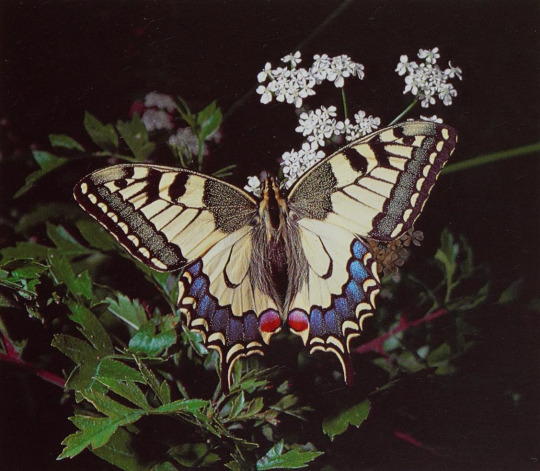
Swallowtail butterfly By: Unknown photographer From: The Grolier Illustrated Encyclopedia of Animals 1994
#swallowtail#butterfly#insect#arthropod#invertebrate#1994#1990s#The Grolier Illustrated Encyclopedia of Animals
2K notes
·
View notes
Text

Effie Lee Morris stands as a towering figure in the realm of children's literature and library services, leaving an indelible mark through her visionary leadership and tireless advocacy. Born into an era marked by racial segregation and systemic barriers, Morris defied the odds, rising to become a beacon of change and progress. Her journey began as a public librarian in Cleveland and later in the Bronx, where she cultivated a deep appreciation for the transformative power of literature and education.
In 1971, Effie Lee Morris shattered barriers as the first African-American president of the Public Library Association, a milestone that underscored her commitment to equity and inclusion in library spaces. Her groundbreaking work extended beyond administrative roles; Morris played a pivotal role in shaping the landscape of children's literature by spearheading the establishment of the Coretta Scott King Award. By crafting the original selection criteria in 1970, she laid the foundation for recognizing and celebrating African-American authors and illustrators, ensuring their voices resonated prominently in the literary world.
Morris's impact reverberated within the walls of the San Francisco Public Library (SFPL), where she assumed the role of the first coordinator of children's services. During her tenure, she revolutionized children's literature by establishing a research collection of out-of-print books, meticulously documenting the evolving portrayals of ethnic and culturally diverse groups. This collection, later renamed the Effie Lee Morris Historical and Research Collection in her honor, served as a testament to her unwavering dedication to preserving diverse narratives and fostering cultural understanding.
Beyond her professional achievements, Morris's advocacy extended into the realm of social justice and community engagement. She founded the San Francisco chapter of the Women's National Book Association and actively participated in the American Library Association's Social Responsibilities Round Table, championing causes aimed at combating racism, inequality, and poverty. Her contributions were met with widespread recognition, as evidenced by numerous accolades, including the Silver Spur Award and the Grolier Foundation Award, affirming her status as a trailblazer in the literary landscape.
Effie Lee Morris's legacy transcends generations, inspiring future leaders and storytellers to uphold the values of diversity, inclusion, and equity in children's literature and library services. Her visionary spirit lives on in the countless lives touched by her work, serving as a timeless reminder of the transformative power of literature in bridging cultures, fostering empathy, and igniting change.
Read more about Effie Lee Morris here.
243 notes
·
View notes
Text
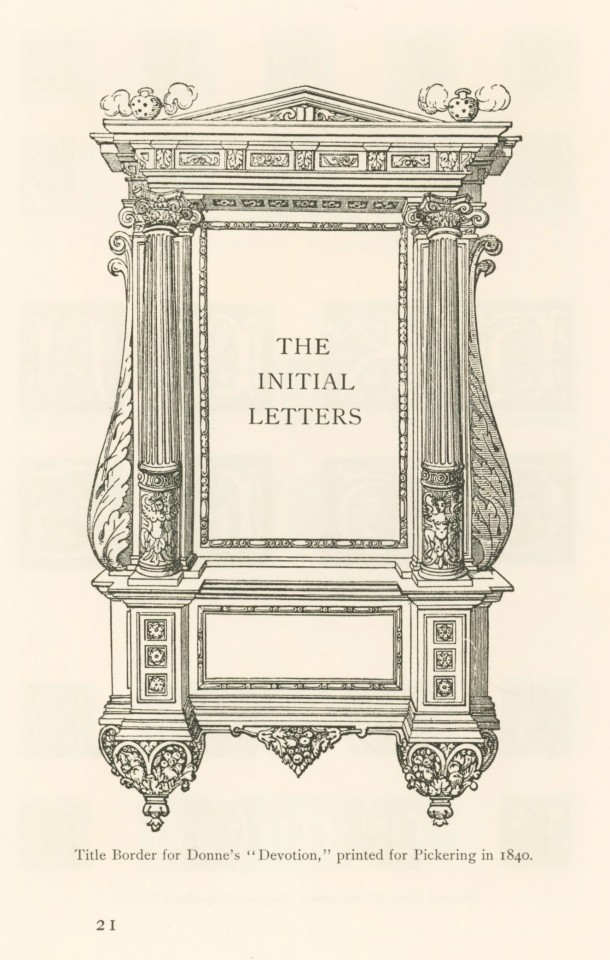

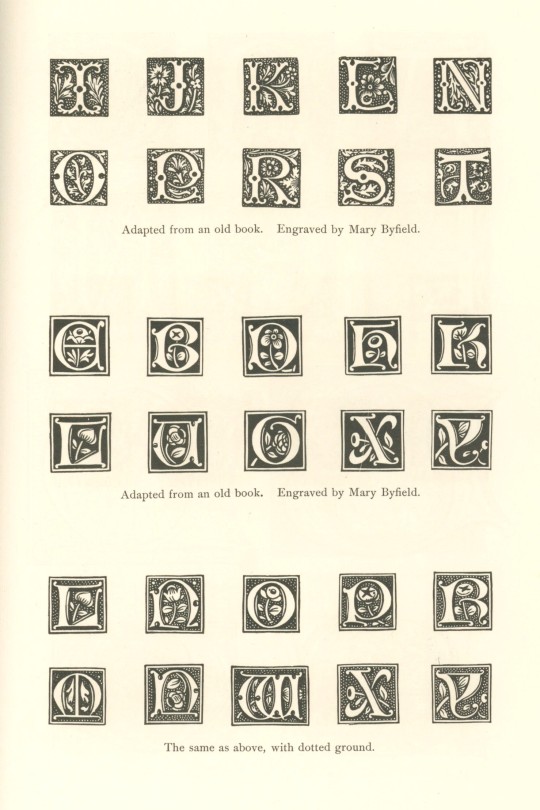
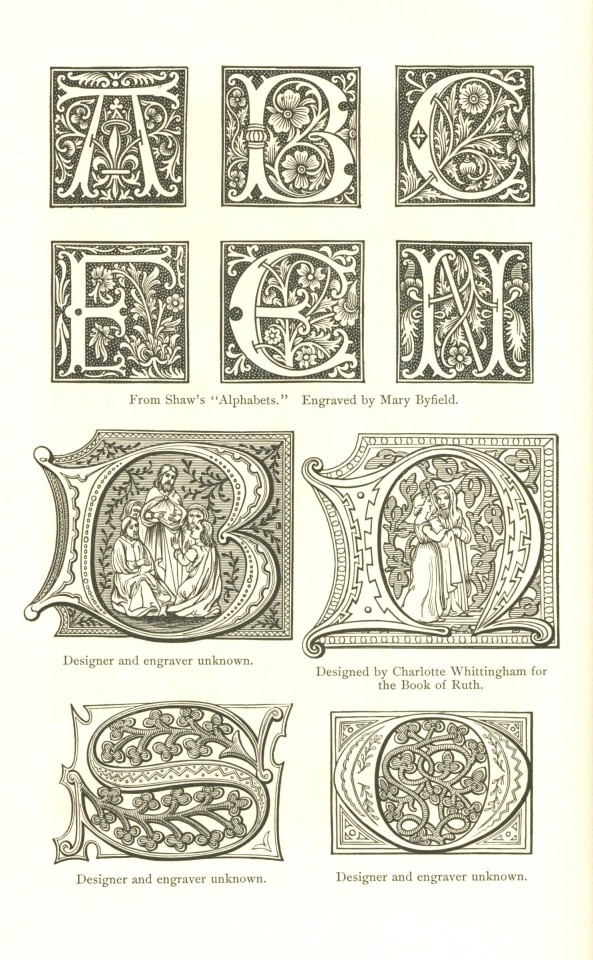
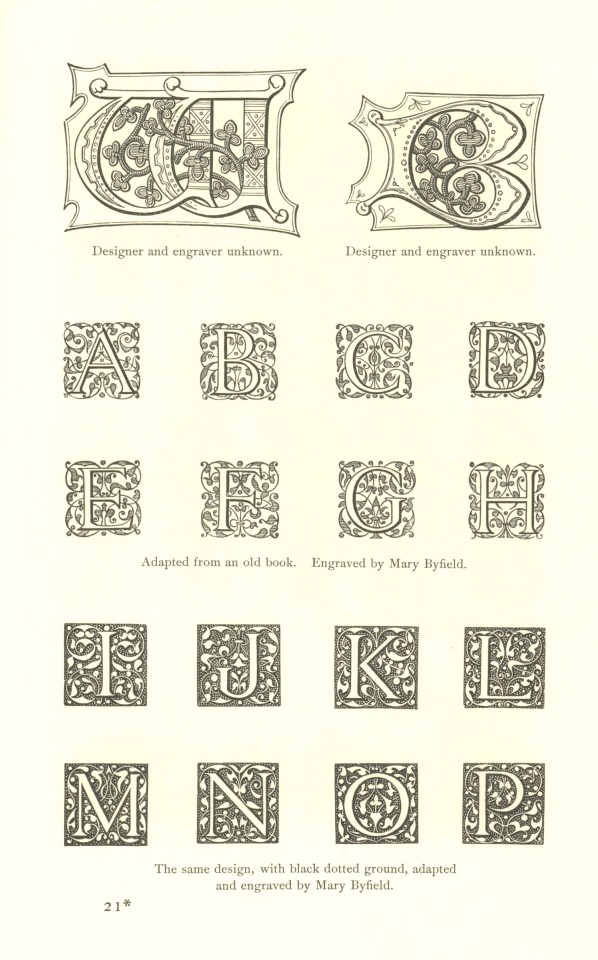
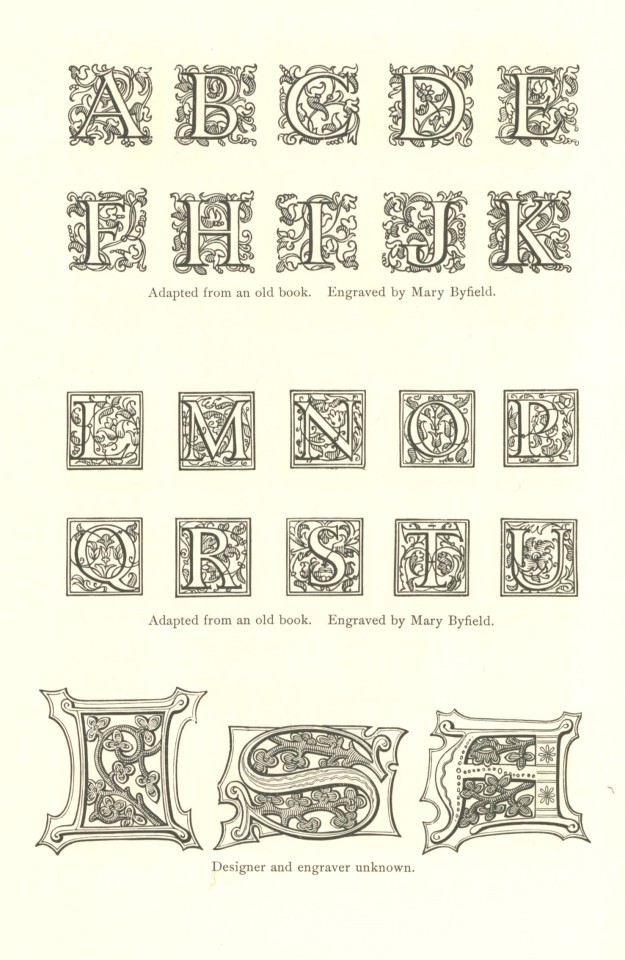
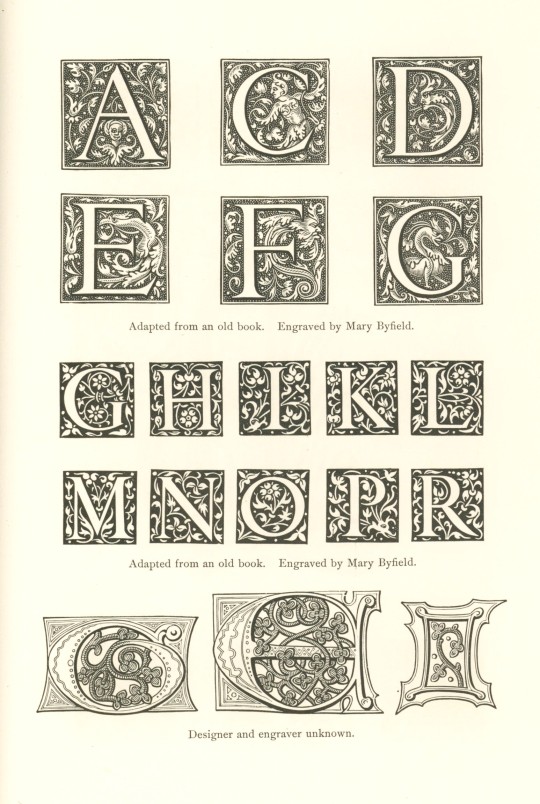
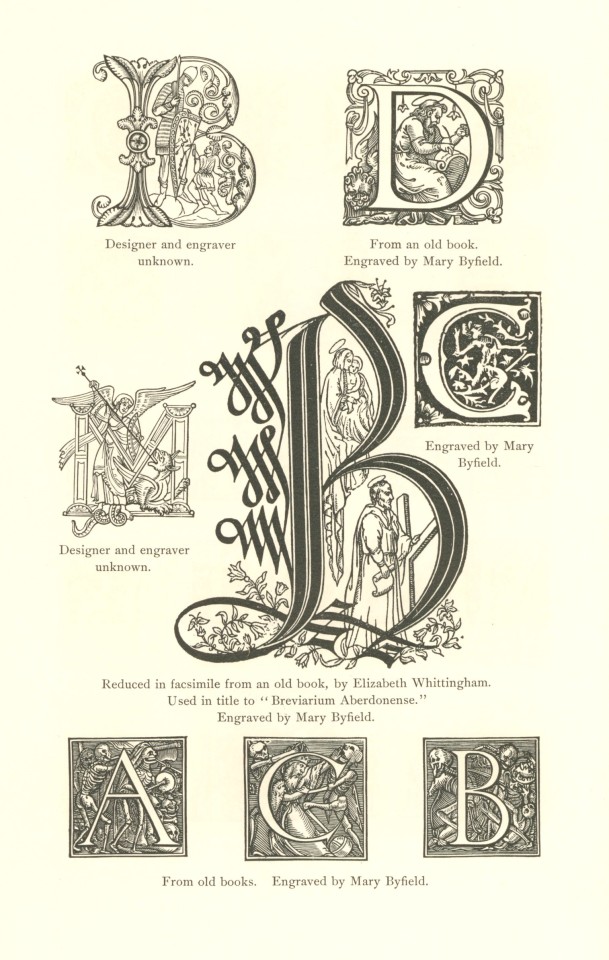
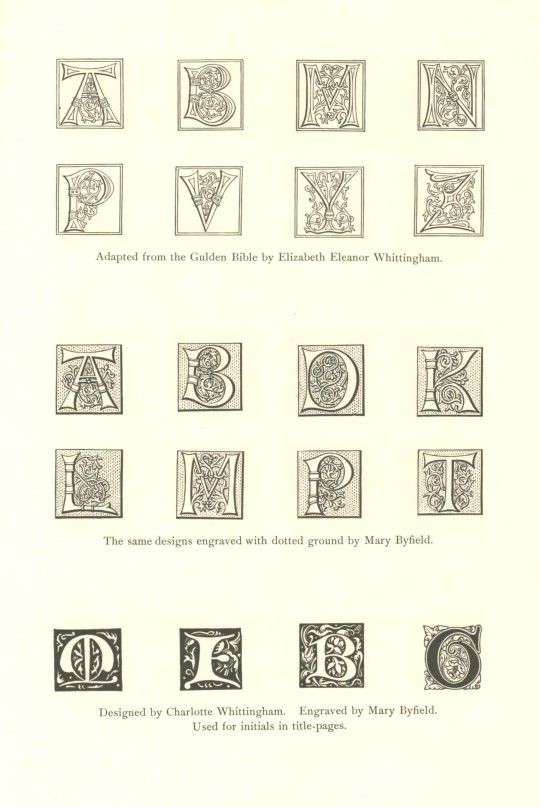

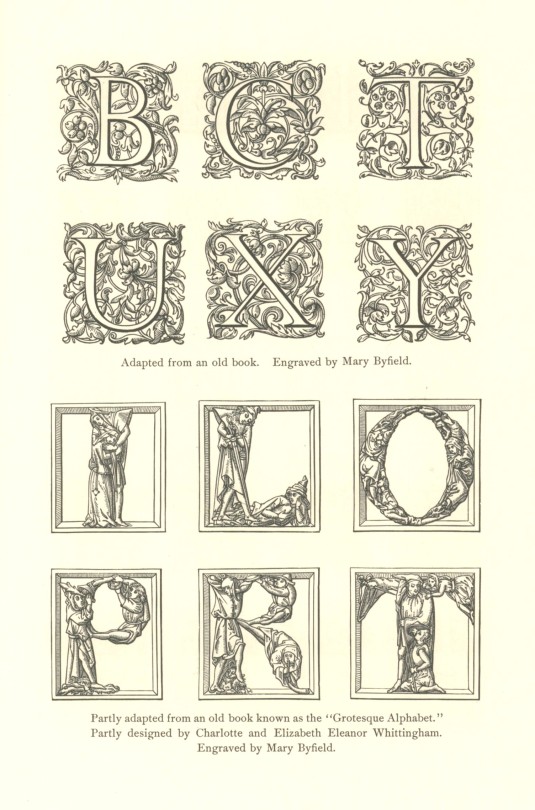
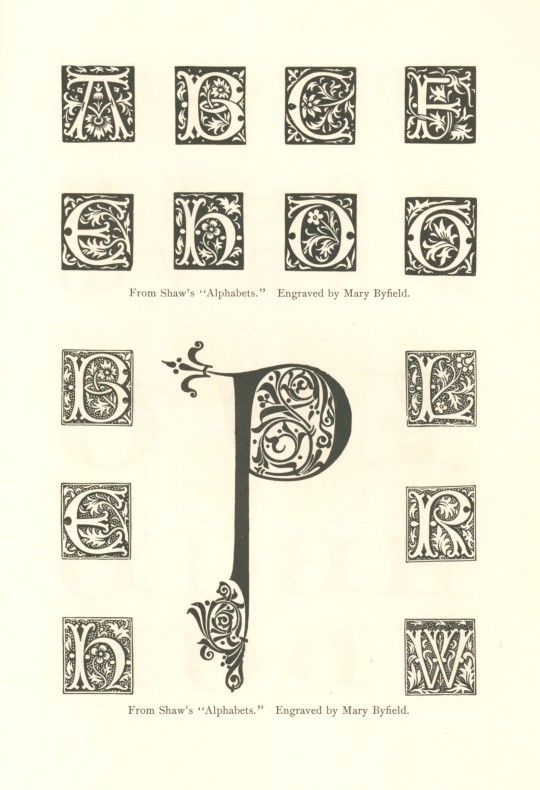
Typography Tuesday
WHITTINGHAM INITIALS
The Whittinghams, Charles the Elder (1767-1840), who founded the Chiswick Press, and his nephew and successor Charles the Younger (1795–1876), were among the finest English printer/publishers of the 19th century, noted especially for the quality of typographic design and evenness of printing. Their firm was also the chief printer for bookseller/publisher William Pickering, whose own devotion to quality was exemplified in his use of Aldus Manutius's anchor & dolphin printer's mark, combined with the motto Aldi Discipulus Anglus (Aldus's English Disciple).
Many of the distinctive, wood-engraved initials the Whittinghams used were designed by Charles II himself along with his artist daughters Charlotte and Elizabeth, almost all of which were engraved by English book illustrator and wood engraver Mary Byfield (1795-1871). The Whittingham initials shown here are from the 1896 Grolier Club publication, The Charles Whittinghams Printers by Arthur Warren (1860-1924), which itself is printed by one of the finest 19th-century American printers, Theodore Low De Vinne (1828-1914), who printed the book on handmade paper in an edition of 185 copies. Our copy is another gift from our friend Jerry Buff, a Grolier Club member.
View our other Typography Tuesday posts.
#Typography Tuesday#typetuesday#Women's History Month#Whittingham Initials#Charles Whittingham#Charlotte Whittingham#Elizabeth Whittingham#William Pickering#Mary Bayfield#wood engravings#initals#The Charles Whittinghams Printers#Grolier Club#Arthur Warren#Theodore Low De Vinne#Jerry Buff#wood engravers#women wood engravers#women type designers#19th century type
119 notes
·
View notes
Text

USA 1993
#USA1993#NEC#HARDWARE#MULTIMEDIA#IBM#NEC MULTISPIN CDROM#WHERE IN THE WORLD IS CARMEN SANDIEGO#MAVIS BEACON TEACHES TYPING#SHERLOCK HOLMES CONSULTING DETECTIVE#GUINNESS DISC OF RECORDS#GROLIER MULTIMEDIA ENCYCLOPEDIA
33 notes
·
View notes
Text
via Gridllr.com — making Likes beautiful again!

Billy in the Darbies: A Facsimile from the Manuscript of Herman Melville's 'Billy Budd, Sailor', [plate 4], Edited by Dennis Marnon, The Houghton Library, Cambridge, MA, 1991 [From the Collection of William Palmer Johnston. The Grolier Club, New York, NY]
Exhibitions: Melville's Billy Budd at 100, The Grolier Club, September 12 – November 9, 2024; Oberlin College & Conservatory Libraries, Oberlin, OH, November 17 – December 20, 2024
#graphic design#manuscript#book#herman melville#dennis marnon#houghton library#collection of william palmer johnston#the grolier club#oberlin college libraries#oberlin conservatory library#1920s#1960s#1990s#2010s#2020s#Billy#Darbies#Facsimile#Manuscript#Herman Melville’s#Billy Budd
15 notes
·
View notes